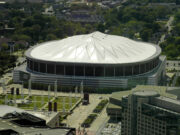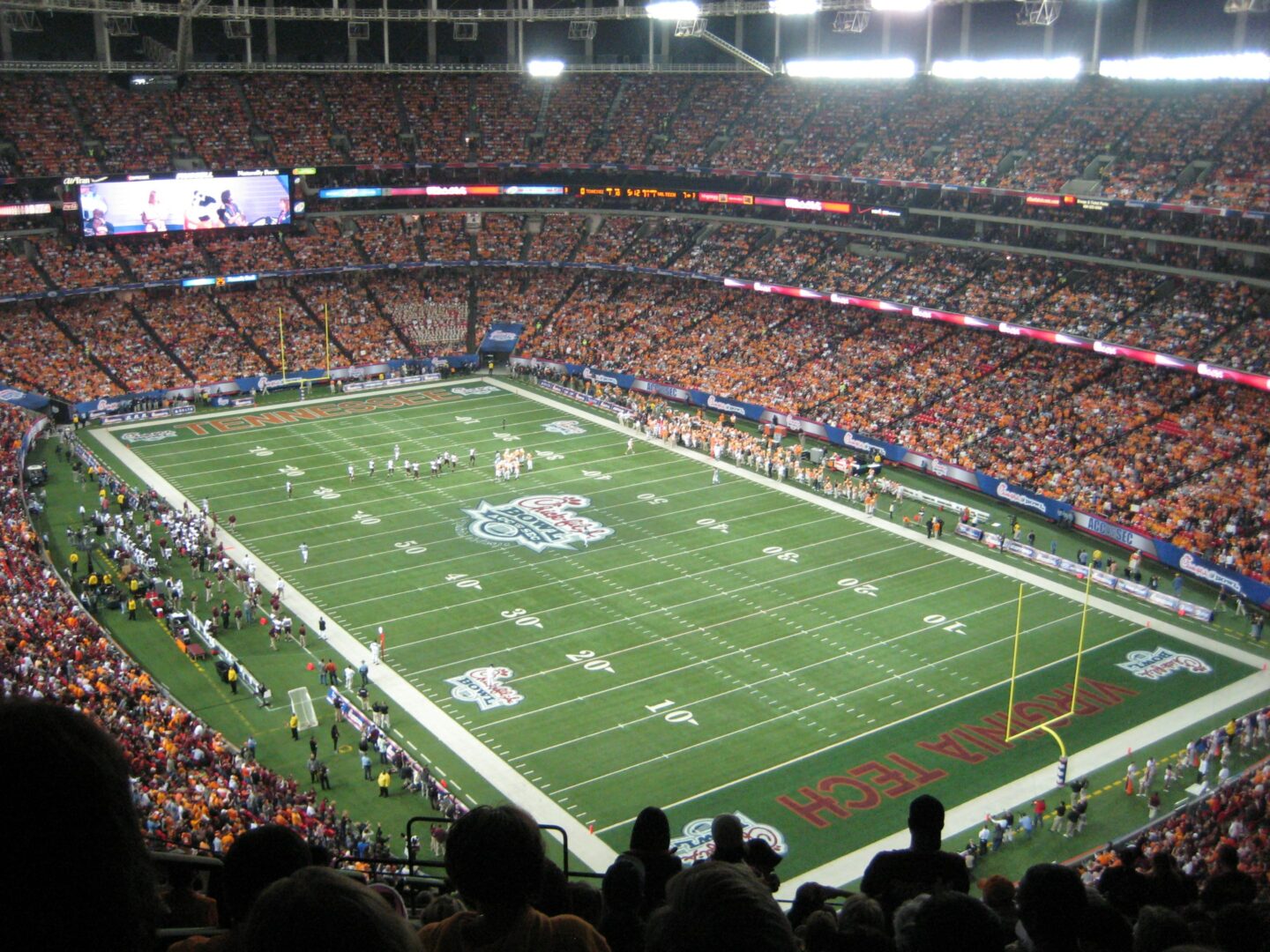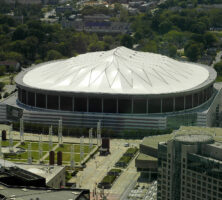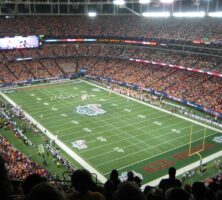The Georgia Dome in downtown Atlanta was best known as the home of the Atlanta Falcons football franchise, but the facility, which opened in 1992 and was demolished just twenty-five years later, also hosted a variety of sporting competitions and other functions, ranging from concerts to trade shows to religious events.

Image from Valerie
In addition to Falcons football, the dome hosted the 1994 and 2000 Super Bowls, the 1996 Olympic Games, the 2002 National Collegiate Athletic Association (NCAA) men’s Final Four basketball playoffs, the 2003 NCAA women’s Final Four, the Southeastern Conference (SEC) and Atlantic Coast Conference men’s basketball tournaments, the SEC football championship game, and the USA Indoor Track and Field championships.
In 1988 former Falcons owner Rankin Smith, who brought professional football to Atlanta and the Southeast in 1965, threatened to move the team to Jacksonville, Florida, or another city if the state of Georgia did not construct a new facility for the Falcons. For twenty-six years the Falcons shared Atlanta
In January 1989 Smith and Georgia governor Joe Frank Harris reached an agreement on a twenty-year lease for the state-owned Georgia Dome. Groundbreaking took place on November 22, 1989, and the facility was completed more than two-and-a-half years later at a cost of some $210 million.
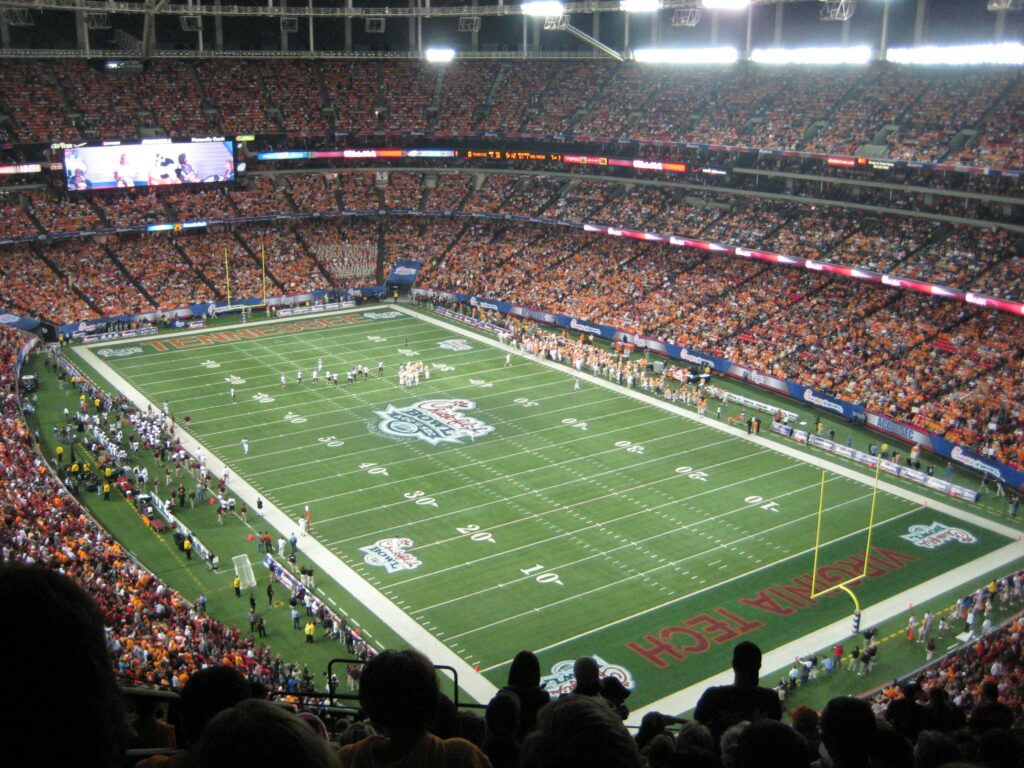
Image from Gary Cope
Construction was financed through tax-exempt bonds issued by the Georgia World Congress Center Authority (which managed the facility, as well as the Georgia World Congress Center and Centennial Olympic Park) and a 2.75 percent hotel/motel tax levied in the city of Atlanta.
When the Georgia Dome opened in 1992, it was the world’s largest rigid cable-supported oval dome. The ceiling of the twenty-seven-story facility was made of a Teflon-coated fiberglass, and there was a five-story atrium in each of the building’s four corners.
Arthur Blank, who bought the Falcons from the Smith family in 2002, hoped to bring the Super Bowl back to Atlanta in 2009 and promised notable changes to the dome’s interior, but the National Football League owners opted in 2005 to award the 2009 game to Tampa, Florida. The proposed improvements to the Georgia Dome were scratched, although around $2 million was spent in 2005 to create the 250-member Owner’s Club in the dome’s lower level.
When Blank, who cofounded Home Depot, bought the Falcons, he not only lowered ticket prices on approximately 23,000 of the dome’s 71,250 seats (which gave the team its first sold-out season in more than twenty years) but also purchased land near the facility, where fans could gather and tailgate before Falcons games.
While the dynamic design of the Georgia Dome was generally praised, the arena experienced one troubling situation in August 1995, when heavy rains pooled in a section of the roof, rending its fabric. The roof was repaired, and a structural adjustment was made to avoid future problems.
Although the Georgia Dome was synonymous with the Atlanta Falcons, more basketball games than football games were played in the facility. Besides the many NCAA basketball games played there, the Atlanta Hawks spent two seasons in the dome while nearby Philips Arena (later State Farm Arena) was under construction. The largest crowd in National Basketball Association history—62,046 fans—visited the Georgia Dome on March 27, 1998, when Michael Jordan played his final game as a Chicago Bull in Atlanta against the Hawks. Jordan scored 34 points to lead his team to an eighty-nine to seventy-four victory.
The Georgia Dome had perhaps its busiest time ever as 2005 gave way to 2006. On December 30, 2005, 65,620 fans were on hand as the Louisiana State University Tigers defeated the Miami (Florida) Hurricanes forty to three in the Chick-fil-A Bowl. The Falcons concluded their season two days later with a forty-four to eleven loss to the Carolina Panthers before a crowd of 70,796. Finally, on January 2, 2006, 74,458 fans saw the West Virginia Mountaineers defeat the Georgia Bulldogs thirty-eight to thirty-five in the Sugar Bowl. The Sugar Bowl moved to Atlanta from New Orleans, Louisiana, after Hurricane Katrina caused extensive damage and flooding in New Orleans in August 2005.
The Georgia Dome was also the site of concerts from major musical performers, including the Rolling Stones, Paul McCartney, U2, the Backstreet Boys, Alabama, and the VIBE Musicfest lineup, and held other events such as major trade shows (including Amway conventions), professional wrestling events, and religious gatherings led by Billy Graham and Bishop T. D. Jakes.
In 2014 the Atlanta Falcons and the City of Atlanta began construction on the Mercedes-Benz Stadium, located immediately south of the Georgia Dome site. The new stadium opened its doors in August 2017, and the Georgia Dome was demolished that November.
In January 2017 the Falcons played their final game in the Georgia Dome, beating the Green Bay Packers to win the National Football Conference championship and a slot in the Super Bowl.


